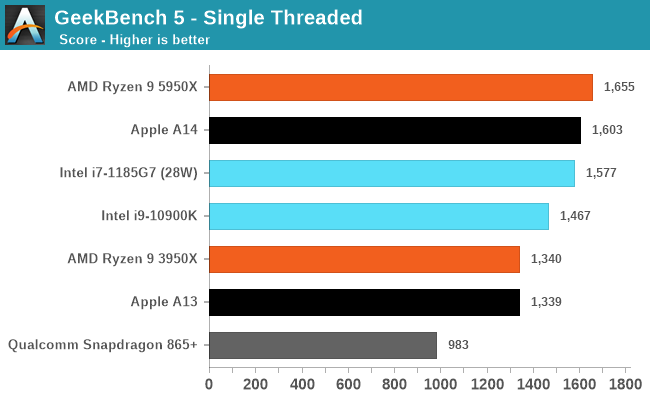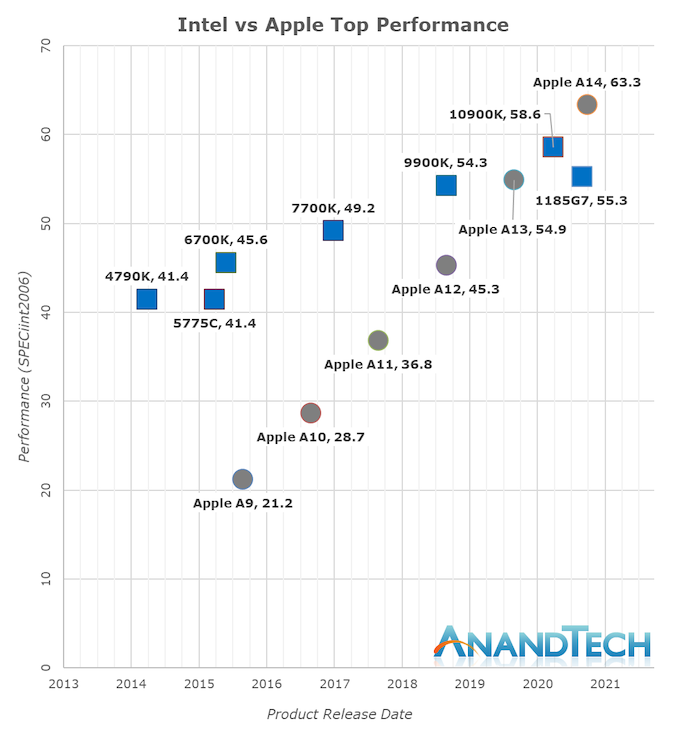Apple Announces The Apple Silicon M1: Ditching x86 - What to Expect, Based on A14
by Andrei Frumusanu on November 10, 2020 3:00 PM EST- Posted in
- Apple
- Apple A14
- Apple Silicon
- Apple M1
From Mobile to Mac: What to Expect?
To date, our performance comparisons for Apple’s chipsets have always been in the context of iPhone reviews, with the juxtaposition to x86 designs being a rather small footnote within the context of the articles. Today’s Apple Silicon launch event completely changes the narrative of what we portray in terms of performance, setting aside the typical apples vs oranges comparisons people usually argument with.
We currently do not have Apple Silicon devices and likely won’t get our hands on them for another few weeks, but we do have the A14, and expect the new Mac chips to be strongly based on the microarchitecture we’re seeing employed in the iPhone designs. Of course, we’re still comparing a phone chip versus a high-end laptop and even a high-end desktop chip, but given the performance numbers, that’s also exactly the point we’re trying to make here, setting the stage as the bare minimum of what Apple could achieve with their new Apple Silicon Mac chips.

The performance numbers of the A14 on this chart is relatively mind-boggling. If I were to release this data with the label of the A14 hidden, one would guess that the data-points came from some other x86 SKU from either AMD or Intel. The fact that the A14 currently competes with the very best top-performance designs that the x86 vendors have on the market today is just an astonishing feat.
Looking into the detailed scores, what again amazes me is the fact that the A14 not only keeps up, but actually beats both these competitors in memory-latency sensitive workloads such as 429.mcf and 471.omnetpp, even though they either have the same memory (i7-1185G7 with LPDDR4X-4266), or desktop-grade memory (5950X with DDR-3200).
Again, disregard the 456.hmmer score advantage of the A14, that’s majorly due to compiler discrepancies, subtract 33% for a more apt comparison figure.

Even in SPECfp which is even more dominated by memory heavy workloads, the A14 not only keeps up, but generally beats the Intel CPU design more often than not. AMD also wouldn’t be looking good if not for the recently released Zen3 design.

In the overall SPEC2006 chart, the A14 is performing absolutely fantastic, taking the lead in absolute performance only falling short of AMD’s recent Ryzen 5000 series.
The fact that Apple is able to achieve this in a total device power consumption of 5W including the SoC, DRAM, and regulators, versus +21W (1185G7) and 49W (5950X) package power figures, without DRAM or regulation, is absolutely mind-blowing.

There’s been a lot of criticism about more common benchmark suites such as GeekBench, but frankly I've found these concerns or arguments to be quite unfounded. The only factual differences between workloads in SPEC and workloads in GB5 is that the latter has less outlier tests which are memory-heavy, meaning it’s more of a CPU benchmark whereas SPEC has more tendency towards CPU+DRAM.
The fact that Apple does well in both workloads is evidence that they have an extremely well-balanced microarchitecture, and that Apple Silicon will be able to scale up to “desktop workloads” in terms of performance without much issue.
Where the Performance Trajectory Finally Intersects
During the release of the A7, people were pretty dismissive of the fact that Apple had called their microarchitecture a desktop-class design. People were also very dismissive of us calling the A11 and A12 reaching near desktop level performance figures a few years back, and today marks an important moment in time for the industry as Apple’s A14 now clearly is able to showcase performance that’s beyond the best that Intel can offer. It’s been a performance trajectory that’s been steadily executing and progressing for years:
Whilst in the past 5 years Intel has managed to increase their best single-thread performance by about 28%, Apple has managed to improve their designs by 198%, or 2.98x (let’s call it 3x) the performance of the Apple A9 of late 2015.
Apple’s performance trajectory and unquestioned execution over these years is what has made Apple Silicon a reality today. Anybody looking at the absurdness of that graph will realise that there simply was no other choice but for Apple to ditch Intel and x86 in favour of their own in-house microarchitecture – staying par for the course would have meant stagnation and worse consumer products.
Today’s announcements only covered Apple’s laptop-class Apple Silicon, whilst we don’t know the details at time of writing as to what Apple will be presenting, Apple’s enormous power efficiency advantage means that the new chip will be able to offer either vastly increased battery life, and/or, vastly increased performance, compared to the current Intel MacBook line-up.
Apple has claimed that they will completely transition their whole consumer line-up to Apple Silicon within two years, which is an indicator that we’ll be seeing a high-TDP many-core design to power a future Mac Pro. If the company is able to continue on their current performance trajectory, it will look extremely impressive.











644 Comments
View All Comments
sonny73n - Saturday, November 14, 2020 - link
We all know Apple is always BS. Somehow their BS always work on some people.Alej - Saturday, November 14, 2020 - link
@sonny73n: really man, who is ‘we all’? That doesn’t include the andand tech writers for sure in that ‘all’. They didn’t find this BS.But alright, fine, let’s not listen to Apple, let’s listen to anybody else NON-Apple: check the leaked M1 benchmarks, single core and multi core through the roof. Integrated GPU compute scores on par with discrete Radeon 580X. Octane X GPU renderer devs stating that they can fit scenes with 100+GB worth of textures in those 16GB UMA. Affinity Photo devs saying that they have increase several fold the equivalent tier from previous generation. DaVinci Resolve having 5x in some parts of their editing. (Again these are not Apple’s statements).
Will it beat the latest RTX cards? Of course not... in the same sense that the latest RTX power hungry constantly thermal throttled crazy heavy laptops won’t last the 20hrs a MacBook Pro M1 can. The two at aiming at different goals.
Also, all the ‘general purpose’ or ‘not general purpose’ comparison or chit chat... what the heck is that coming from. I’m just a normal user, I boot my machine and launch ANY GENERAL PURPOSE program... and it runs faster, better, leaner, quieter; but then I’ll complain? “fine, but it’s maybe not general purpose so I’ll go to these other systems that do exactly the same but slower, but hey, they are REAL general purpose”.
Excuse me the rant vibe, I understand there’s the blind sheep Apple following and the gratuitously apple haters. There’s a middle ground, just look at the numbers for the fun of it... and actually, maybe even don’t if the device wouldn’t even be something to be considered for purchase. You know why I never go around Lamborghini shops bashing or criticizing their cars? Because I’m honestly not interested in buying one.
novastar78 - Wednesday, November 11, 2020 - link
You got man!The question I have it, can it run Crysis?
This is all just Apple fan boys getting worked up. I'll most likely never own an Apple product so for us old guys this is just fluff.
Its just an ARM chip with a PowerVR GPU (that they stole). Not seeing the big deal here except for the Appleites
Spunjji - Thursday, November 12, 2020 - link
@novastar78 - "Its just an ARM chip with a PowerVR GPU (that they stole). Not seeing the big deal here except for the Appleites"One of the world's most popular and influential computer manufacturers is producing an ARM-based chip that beats the pants off Intel's best in terms of power-efficiency *and* performance, and slaps AMD around for power... and that's NBD to you? Okay. I guess you're just not that interested in tech 🤷♂️
vais - Friday, November 13, 2020 - link
@Spunjji - three times hurray for jumping to conclusions! But it's not really your fault, the benchmarks don't say they are only single threaded... M1 will absolutely be more power efficient than both Intel and AMD - but to have more performance total, when all are running all cores at normal power? People's daydreams will be shattered when real benchmark results are released.star-affinity - Friday, November 13, 2020 - link
@vaishttps://browser.geekbench.com/v5/cpu/4648107
Daydream?
vais - Friday, November 13, 2020 - link
I'm not convinced by geekbench results. If we look there, Snapdragon 865 is half the single-core performance of 5900X.If that was true and actually translated to real world performance, a lot of services would have transitioned to those fabled ARM chips.
Spunjji - Friday, November 13, 2020 - link
@vais - "If that was true and actually translated to real world performance, a lot of services would have transitioned to those fabled ARM chips" - have you even paid attention to what's happening with Graviton?https://www.anandtech.com/show/15578/cloud-clash-a...
Alej - Saturday, November 14, 2020 - link
@Spunjji just wanted to chime in as I have noted the effort at keeping it all quiet and factual. Not jumping to hasty conclusions and pointing out facts/numbers where available. I was already convinced but even got extra pointers out of the sometimes out of whack discussions.Hats off, that’s hard work.
GeoffreyA - Sunday, November 15, 2020 - link
100%. Spunjji is always bringing sense and sanity back to conversations, and he's critical and objective. I always look forward to his comments.